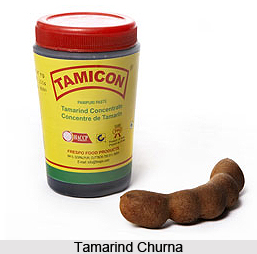 Uses of Tamarind are many and very beneficial to mankind. Its uses comprise culinary uses, medicinal value, carpentry uses and many more. Tamarind belongs to the Leguminosae family and its botanical name is Tamarindus indica. Tamarind is a long bean-like pod belonging to the vegetable order, but is treated like a fruit. The name is derived from the Arabic "tamar", meaning a "dry date fruit".
Uses of Tamarind are many and very beneficial to mankind. Its uses comprise culinary uses, medicinal value, carpentry uses and many more. Tamarind belongs to the Leguminosae family and its botanical name is Tamarindus indica. Tamarind is a long bean-like pod belonging to the vegetable order, but is treated like a fruit. The name is derived from the Arabic "tamar", meaning a "dry date fruit".
Culinary Uses of Tamarind
The fruit pulp of Tamarind is edible and popular. It has a wide spread use to make `chutney`, jam, jelly and sauce. Tamarind has several usages in making of Indian dishes. The fruit pulp is sour and acidic. Ripened tamarinds are sweeter and are used to make delicious desert items. The pulp is needed to make Worcestershire sauce.
In Regional cuisines, such as Rajasthan, Maharashtra, Tamil Nadu and Andhra Pradesh, Tamarind is used to make rasam, sambhar, vatha kuzhambu and puliyogare. In Andhra Pradesh and Tamil Nadu, tender leaves of tamarind are used with lentils, and it is also dried and used in place of ripe tamarind for mild flavour. In southern parts of Kerala, mostly in the coastal belt, it is added to fish curry, masalas and ground coconut for flavouring.
Medicinal Uses of Tamarind
Apart from the culinary uses, Tamarind is largely used for its medical benefits. Tamarind is used in Indian Ayurvedic medicine to treat gastric and digestion problems, and in cardio protective activity. In animal studies, tamarind has been found to reduce serum cholesterol and blood sugar levels.
As per human study, tamarind intake delays the progression of skeletal fluorosis by enhancing excretion of fluoride.
Other medicinal uses comprise Anthelminthic (expels worms), antimicrobial, antiseptic, antiviral, asthma, astringent, bacterial skin infections (erysipelas), boils, chest pain, cholesterol metabolism disorders, colds, colic, conjunctivitis (pink eye), constipation (chronic or acute), diabetes, diarrhoea (chronic), dry eyes, dysentery (severe diarrhoea), eye inflammation, fever, food preservative, food uses (colouring), gallbladder disorders, gastrointestinal disorders, gingivitis, haemorrhoids, indigestion, insecticide, jaundice, keratitis (inflammation of the cornea), leprosy, liver disorders, nausea and vomiting (pregnancy-related), paralysis, poisoning (Datura plant), rash, rheumatism, saliva production, skin disinfectant/sterilization, sore throat, sores, sprains, sunscreen, sunstroke, swelling (joints), urinary stones, wound healing (corneal epithelium).
Carpentry Uses of Tamarind
Tamarind fruit pulp is used to polish the brass shrine furniture, removing dulling and the greenish patina that forms. The Tamarind tree wood is of bold red colour. For its density and durability, tamarind heartwood is used in making furniture and wood flooring.
Tamarind trees can be found in a large number in south India. They are used to enhance the shade of the roads. The seed oil of tamarind is used to linseed oil. It is suitable for making paints and varnishes. The Tamarind woods are also used as fuel in the ovens of brick factories which require high temperatures.




















